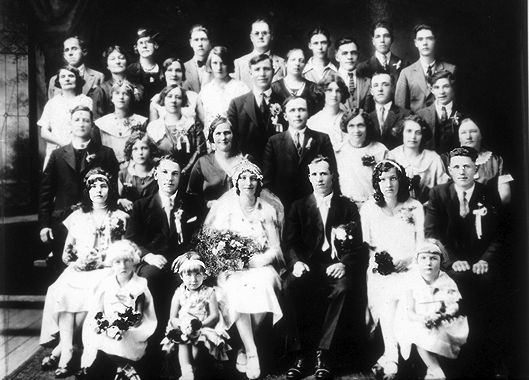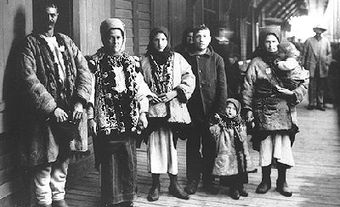
Traditional Christian concepts of marriage dominated Canadian society since the founding of the country. Since the end of the Second World War, however, the formal rules, family customs and societal expectations around marriage and divorce have steadily been eroded and relaxed.
Basic Marriage Patterns
Canadians have always followed the marriage pattern dominant in Western societies – relatively late marriage, companionable unions and a significant proportion of individuals who remain unmarried. Before the Second World War, nine out of 10 adults in Canada had married at least once in their lives. The average age of grooms at first marriage was between 25 and 29; the average age of brides was between 20 and 25.
Then, as today, three basic factors influenced the opportunity to marry and the timing of marriage:
First is the ratio of marriageable males to females. In Canada this ratio has varied widely over time. Overall the numbers of unmarried men and women have been more or less equal. However, during times of high immigration, and in frontier areas, men outnumbered women. Also, from 1850 onward women have outnumbered men in the growing industrial cities of central Canada.
Second, the strong tendency of men to marry women younger than themselves has affected the marriage opportunities of prospective brides and grooms in quite different ways. The selection of potential spouses for women has always been greatest when women were young; for men, on the other hand, the choice of mates expanded steadily as they aged.
Third, economic factors have always affected marriage opportunities, especially for men. Until recently a man found it more difficult to marry until he could support a wife and children.
Role of Religion
Long before the founding of Canada, the Catholic and Protestant churches had established that marriage was a lifelong, exclusive union of one man and one woman who freely consented to join their lives for procreation and mutual comfort. However, the various Christian denominations were divided on several issues. The Roman Catholic Church held marriage to be a sacrament (a sign of God's presence), while Protestants simply considered it blessed by God.
Catholics believed the marriage bond lasted until death, while Protestants accepted the possibility of divorce and remarriage in limited circumstances. Catholicism prohibited a broad range of unions among people, but offered some leeway in the enforcement of its rules. Protestantism imposed fewer restrictions on who a person could marry. Despite these differences, broad agreement on the fundamentals of Christian marriage existed in western Europe after the Reformation. These beliefs and ideas were brought to Canada by European settlers and church leaders.
Indigenous Customs
There was no single or uniform marriage tradition practiced by First Nations and Inuit people before the arrival of the first European explorers and settlers. Marriage rites and customs differed across the continent. Generally, however, marriage was a common practice. Men tended to be older, marrying when they could provide for a family; women were younger, marrying when they reached puberty.
Women were often equal in status to men in Aboriginal communities and, like the men, were usually free to choose when and whom to marry, and also to end marriages. The exception were women taken as prisoners during warfare. Divorce did not carry the stigma attached to it in the Christian traditions brought to North America by European missionaries and settlers. Polygamy was practiced in some tribes, with men having more than one wife. A bride price would often be paid by the groom to the bride's family before a marriage could take place. Marriage ceremonies were usually elaborate community affairs, with gift-giving, smoking of a symbolic pipe, and feasting and dancing taking place after dusk (see Potlatch).
Marriage between people of different First Nations, and also between men and women from various Inuit groups, was practiced sometimes as a means of establishing political and economic alliances. During the fur trade, inter-racial marriages – usually between male European traders and Aboriginal women – also occurred and were sometimes encouraged by both sides. (The children of some of these unions would go on to form the Metis Nation.) Such marriages alleviated the harshness of frontier life for many men, who also relied on their Indigenous wives to help them survive in the wilderness. The marriage of prominent fur traders or administrators to the daughters of Aboriginal leaders also served as a means of securing trade networks through kinship.
Today, while many contemporary Indigenous couples have adopted Christian or other western marriage practices, traditional elements of wedding rites and marriage customs have not completely disappeared.
Choosing a Spouse
European settlement brought with it Christian marriage concepts, which have dominated the history of Canada since that time. Some evidence suggests the existence of arranged marriages among bourgeois families in New France, but for the most part men and women have always chosen their own spouses. In addition to economic considerations, Canadians have tended to marry within their own social groups, therefore ethnicity, religion and class have played an important role in the process of mate selection. Within these boundaries (and occasionally outside of them) personal attraction has also been an extremely important motive for marriage in Canada.
Historically, the romantic basis of marriage was regarded with ambivalence. Although unions founded on personal choice and emotional attachment offered the promise of happiness and personal fulfillment through companionship, they also required lengthy, private courtship and contained hidden dangers, including the possibility of imprudently choosing a spouse by yielding to the dictates of the heart and not the mind.
Another danger was the prospect of sexual intimacy before marriage, which was an offence against respectable opinion and religious teaching, and a decision that carried the risk of childbirth outside marriage. Censure of non-marital sexual intercourse served two important functions. It affirmed high ideals of personal conduct, particularly for women, and it also constituted protection for the interests of women and children whose greatest economic security, before the age of the welfare state, lay in marriage and family life.
Community and Family Influence
For these reasons, family and community influences exerted strong control over courtship in Canada until almost the end of the 19th century. Couples exploring the possibility of marriage courted largely in their own homes under the watchful gaze of their families. They also passed time together in the homes of relatives and friends, in church, at community events, and out of doors on strolls, sleigh rides and incidental pastimes. These circumstances gave parents an effective control over courtship, especially those of their daughters. In urban middle-class circles, where "calling" and "at homes" formed part of customary social life, a mother admitted to the home only those young men she considered fit companions for her daughters. The annual "coming out" ceremonies, so carefully arranged by mothers, formally placed young women in a marriage market regulated by adults.
Urban working-class families had less influence over their courting young, for their children often worked and boarded away from home after mid-adolescence. Instead, the families with whom youths lived often oversaw their conduct, though perhaps with something less than due parental care. In rural communities courtship also fit in and around the common customs of social visiting, church attendance and everyday recreations.
Since the 1880s, controls regulating courtship and youthful social life in Canada have gradually relaxed. Parental restrictions during late adolescence were indirect through youth clubs, schools, residences, church groups and other institutions that increasingly framed the lives of the young. The transportation revolution after the turn of the 20th century also increased youthful independence. Greater mobility brought freedom from parental and community supervision, especially in larger cities. Generally speaking, the urban young achieved earlier and more extensive freedom than their rural counterparts, for they had easier access to the quasi-privacy that anonymity offers to city dwellers. In these circumstances courtship became an increasingly private matter.
Parental Approval
Throughout the history of marriage in Canada, the decision to marry has always belonged to the couple, but until the 1880s a young woman's choice of a spouse was still commonly subject to parental approval. From time to time, fathers and mothers refused to allow a daughter to wed the man of her choice, the usual justification being that the alliance was not in her best interest. In these circumstances a woman might defy her parents and marry against their will, but she did so at the risk of estrangement from her family.

Although the parental veto was a heavily qualified power, its strength declined as a daughter's age increased, and it could not be used more than once or twice without inviting defiance. During the 1880s women began to free themselves from this and many other restrictions, and today women usually marry whomever they please. Men, by contrast, have always been far less constrained by parental wishes when choosing a spouse. And from the earliest days of colonial settlement they were relatively free agents on the marriage market.
Marriage Rites
In the past, marriage in Canada was usually a religious rite. Civil marriage has always been possible, at least since the end of the French colonial era, but until recently it has been relatively uncommon. The secular custom of a honeymoon after the wedding developed slowly during the 19th century. Initially, only the well-to-do had money and leisure enough for a post-marriage vacation, but after 1850 the practice spread gradually throughout all social levels. The purpose of the honeymoon has changed considerably over time as well. At first it took the common form of 19th-century social visiting. The recently married couple often travelled with relatives and visited friends and relations in distant communities. But by the end of the century, the honeymoon had become a private holiday for the newly wedded pair.
Divorce
The history of divorce in Canada contrasts sharply with that of marriage for, while most Canadians married, divorce was extremely uncommon until after the Second World War. In fact, until that time, Canada had one of the lowest divorce rates in the Western world. Respectability – articulated by social and religious leaders – condemned divorce as a threat to the family, and the strength of this opinion prevented the relaxation of Canadian divorce laws. Consequently, access to divorce in Canada was extremely limited until 1968.
For most of Canada's first century adultery was virtually the only basis for divorce and, before the First World War, only Nova Scotia, New Brunswick and British Columbia had divorce courts, although Alberta, Saskatchewan and Ontario created them during the interwar period. In provinces without access to judicial divorce, the only alternative was an appeal to Parliament for a statutory divorce, an expensive process that limited access to the wealthy. The most common divorce alternatives were desertion, legal separation and divorce in an American jurisdiction which, though it had no legal force in Canada, seemed to satisfy public opinion.
Alternative Unions
In the 21st century, marriage in Canada no longer requires the union of a man and a woman. In 2003 some provinces began legalizing same-sex marriages, and in 2005 the federal Civil Marriage Act made same-sex marriage legal across the country. Some religious denominations, however, continued to restrict church marriage ceremonies to opposite-sex couples.
The other major change to marriage in Canada in recent decades has been the growing preference for couples not to formally marry, but to live in common-law relationships. Canadian couples who live together for at least a year generally have the same legal and taxation rights and obligations as married couples.

 Share on Facebook
Share on Facebook Share on X
Share on X Share by Email
Share by Email Share on Google Classroom
Share on Google Classroom
